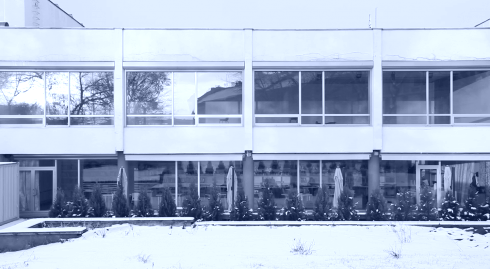MEEL. VAHTRA. FARKAS_ idealist function
An idealist once wondered how big is an idea, how big is a feeling, how much space a memory takes and then, suddenly, she was in many places at once. The exhibition MEEL. VAHTRA. FARKAS_ idealist function presents three Estonian artists from different generations whose work shares a common ground of spatial poetry.This idealist function is based on dialogue inspired by the first concrete poetry manuscript The Club (1968–1969) by Raul Meel.
Since the 1970s, the engineerturnedartist, Raul Meel has formed larger than life worlds with his typewriter and geometrical forms. In his bold, lively work, typed letters become figures telling various stories on love and life. Similarly to Meel, text and repetition are the essential basis for the work of Dénes Farkas, a carpenter turned photographer. Farkas’ method deconstructs sentences and, in turn, subjectively reshapes meanings, sometimes to the extent of becoming autobiographical.Whilst Meel and Farkas are rooted in language and word play, the work of photographerandinstallation artist Anu Vahtra is centred on spatial renditions. She creates site-specific installationsusing the grid as a method as well as an outcome.
All three artists obsessively seek a playful openness by producing serials of idealist functions (a title loaned from Raul Meel’s print in The Club series). Meel works to find a composition that expresses some kind of right until he comes up with an ideal balance. The Club consists of 63 typewriter drawings, of which each form a separate character and story. The individual word is exempt from the suppression of linear sentences. This inspirational manuscript from the late 1960s is one of the first artist books in Estonia. Another work by Raul Meel in that exhibition is Transformations of the Life (1972), which opened the typographic structures period in his oeuvre; the narrative depicts two figures in dialogue, in which the same geometrical circles are layered on top of each other creating a love-like poem.
Dénes Farkas is more focused on the impossibility of finding means of communication for transferring a pure thought from one to another. Whilst Meel in The Club series plays around with one word and its various meanings, Farkas narrates sentences and chapters. His library of 10,000 books is a fruitless attempt to find the meaning of life so as it is eighty framed books, where Bruce Duffy’s novel The World As I Found It is deconstructed into abstracts of a thought. Farkas renders his subjects into the organic abstraction with his new body of work, which has been created especially for this exhibition. Again he uses constant repetition of the same elements to create a matrix.
Anu Vahtra’s works play with our visual perceptions and the error of the camera lens and eyes, creating different realities through repetition. It draws from Raul Meel’s Transformation of the Life and at the same time is inspired by moiré patterns, which she finds in everyday environments. By illuminating the invisible particles, she transmutes and translates them to visible reality.
MEEL. VAHTRA. FARKAS_ idealist function is a three-way trialogue that aims to question simple and basic matters within the world inside and around us.Raul Meel, Anu Vahtra and Dénes Farkas have come together to create apoetry of the invisible, of infinite, unexpected possibilities in which knowledge of the world tends to dissolve the solidity of the world, leading to a perception of all that is infinitely in transformation.
The exhibition is accompanied by an essay by Kaisa Eiche.
Exhibition MEEL. VAHTRA. FARKAS- idealist function will remain open until 18 March 2015. The vernissage will be held on Friday 30 January at 6pm and will feature a special experimental hip-hop music performance by rin la at 9:30pm in the Basement Hall.
***
Organised by Center for Contemporary Arts, Estonia (cca.ee) andContemporary Art Centre, Vilnius (cac.lt)
Presented with theArt Museum of Estonia
Supported by the Estonian Ministry of Culture and Estonian Cultural Endowment
We are particularly thankful to the Estonian Embassy in Vilnius, Andres Amos, Kaisa Eiche,Mikk Heinsoo,Eha Komissarov, Kaie Kukk, Kersti Kuldna, Tõnu Narro, Sten Ojavee, Margit Pajupuu, Valmar Pappel, Rebeka Põldsam, Elnara Taidre, Annika Räim,Indrek Sirkel, Anne Untera, Raivo Välisteand all others who have helped to make this project .
_____________________________________________________
Raul Meel (1941) is known as a radical art innovator, notable autodidact and outsider artist who has expanded the borders of contemporary Estonian art since the 1970s. He is a living classic, whose works were banned in the Soviet Union; therefore, quite often his oeuvre is discussed in terms of a political discourse that emphasises difference and antagonistic opposition to the dominant art system. Meel independently developed the technology of typewriter poetry with which he compiled two manuscripts. One of them, The Club (1968–1969), is also being exhibited at the present exhibition. In 2015, Raul Meel received a lifetime achievement award from Estonian Cultural Endowment.
Anu Vahtra (1982) is an emerging artist whose main focus lies in photography and large-scale spatial installation. She is also involved in numerous collaborations across fields, especially in graphic design and art publishing. She is a co-founder of Lugemik Publishing (2010) and Lugemik Bookshop (2013). In recent years, she has gained more attention with her spatial and bodily installations for which she has been nominated for several Estonian art prizes, including the Sadolin art prize and Köler Prize.
Dénes Farkas (1974)is a post-conceptual photo artist. Since the late 2000s he has primarily focused on contemplating social structures and reflecting the results using a laconic visual language that unites photography and captions as a means of expression. He represented Estonia in the 55th Venice Art Biennale in 2013 and this exhibition at CAC features two pieces from that commission: Evident in Advance ( the library) and 80 framed books
Farkas’ work has been acquired by both private art collectors and the Art Museum of Estonia.
